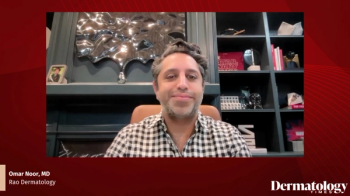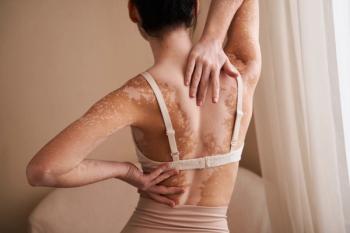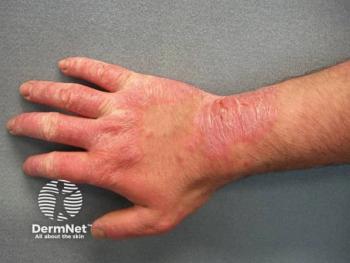
- Dermatology Times, May 2025 (Vol. 46. No. 05)
- Volume 46
- Issue 05
Closing the Gap in Pediatric Atopic Dermatitis: Experts Push for Steroid-Free Advancements
Key Takeaways
- Recent advancements in pediatric AD treatment include nonsteroidal topicals and systemic therapies, transforming care approaches and emphasizing early intervention.
- Nonsteroidal topicals like roflumilast and tapinarof offer safe, effective options for children aged 2 to 11, addressing steroid phobia concerns.
Discover the latest advancements in pediatric atopic dermatitis care, featuring expert insights on innovative treatments and family-centered management strategies.
At the 2025 American Academy of Dermatology Annual Meeting, Dermatology Times hosted a special edition of its Expert Perspectives series titled
A Shifting Treatment Paradigm for Pediatric AD
The past few years have ushered in a transformation in how dermatologists approach pediatric AD, especially with an expanding array of nonsteroidal topicals and systemic therapies. “We are entering a whole new era of the treatment of atopic dermatitis in our youngest patients, and it has been a long time coming,” Swanson said. Until recently, pediatric treatment options were largely limited to topical corticosteroids and calcineurin inhibitors. However, newer agents—including aryl hydrocarbon receptor modulators and topical JAK inhibitors—are shifting the paradigm.
Golant emphasized the significance of early intervention when it comes to treating AD. “We know that atopic dermatitis, as a disease state, often begins in childhood,” she said. “There’s been a lot of attention paid to whether early intervention could change the course of the disease over time.” She noted that the therapeutic toolbox has grown dramatically and now includes nonsteroidal agents with promising safety and efficacy profiles in children as young as 2 years.
Nonsteroidal Topical Options in Younger Children
Although the therapeutic landscape for AD has broadened considerably, clinicians often highlight a persistent gap: the lack of effective, well-tolerated nonsteroidal topicals for younger children, particularly those aged 2 to 11 years. For families wary of long-term steroid use or systemic agents, this age group often falls into a treatment gray zone.
“If steroid phobia had to reach a fever pitch at any point in history, I’m so glad it’s now,” Swanson said, “because we have 3 wonderful topical steroid-free options that we can offer to our patients.”
Swanson highlighted the current options, including roflumilast down to age 6 and tapinarof down to age 2, and discussed her anticipation for additional indications for topical ruxolitinib cream.
“I cannot wait for topical ruxolitinib to get the label expansion down to the age of 2,” she said. “We’ve known topical ruxolitinib for the past 3 years for patients aged 12 and up, and it has been a wonderful addition to our therapeutic arsenal. It is a powerful topical nonsteroid. In my opinion, it works as well and as fast as a steroid, without being a steroid.”
Clinical data on topical ruxolitinib in the 2-to-11 age range have mirrored adult results, with fast onset, robust efficacy, and reassuring safety and tolerability. “We’re talking very quick onset,” Song said. “If we were to look at the graph or the curves, it’s almost straight up and down how quickly this works. We’re seeing a real depth of response.”
Realities of Disease Burden and Familial Impact
Beyond its clinical presentation, pediatric AD imposes a profound burden on family life. “Pediatric atopic dermatitis affects not just the child but really the entire family,” Soung said. She identified disrupted sleep, emotional stress, routine interruptions, and financial strain as widespread consequences. “It almost feels like the atopic dermatitis is taking control of their lives,” she added.
Parents often arrive at the dermatologist’s office overwhelmed by complicated regimens and fear of long-term adverse effects. “There is still a lot of steroid phobia,” Soung explained. “Parents are worried about skin thinning, withdrawal effects, and systemic absorption.” These concerns—frequently magnified by social media—can lead to poor adherence and suboptimal disease control.
Swanson agreed, highlighting the importance of simplifying treatment plans. “In the past, I created some very complicated regimens,” she said. “Even a dermatologist couldn’t keep up with that.” With the availability of safe and effective nonsteroidal topicals, clinicians are now better equipped to tailor regimens that are realistic and sustainable for families.
Balancing Safety and Efficacy in Younger Patients
For all panelists, safety remained paramount in choosing therapies for younger children. “As a father of 4 kids, I want to make sure anything I’m giving to my child...is going to be safe,” Farberg said. He explained that the safety signals for topical JAK inhibitors differ substantially from their oral counterparts, with studies showing minimal systemic absorption. “Really, the main effect will be that your child is going to get a lot better,” he added. “The benefit far outweighs any risk.”
Swanson echoed this confidence, stating, “Our topicals are really quite safe and have a very reassuring safety and tolerability profile.” She also stressed the importance of clinician-parent communication, especially when discussing black box warnings. “It’s really important to become familiar with the box warning yourself as a dermatology clinician,” she said, “and be able to have that conversation with patients and their families in a confident, reassuring, but thorough way.”
Bridging the Gap in Moderate Disease Management
Despite therapeutic advances, treating patients with moderate disease continues to be a challenge. “We do a really good job of treating bad AD and very limited AD, but the patients in between—that’s where we still struggle,” Song said. Many systemic therapies are not approved for use in children under 12 years, and parents may hesitate to initiate a lifelong injection or pill. At the same time, multiple topicals with limited effectiveness or tolerability can create complex regimens that frustrate adherence.
Song pointed to nonsteroidal options as a possible bridge for this underserved group. “You can imagine these patients are leaving your clinic with 3, 4, 5 different topicals,” he said. “I can’t keep these things straight. I can’t imagine a parent or a patient doing that.” For some patients, simplifying the regimen and starting with a well-tolerated topical may delay—or even prevent—the need for systemic therapy.
Looking Ahead: Empowering Families and Providers
Education, accessibility, and ongoing innovation will shape the future of pediatric AD care. Swanson underscored the need for caregiver engagement: “They are the boots on the ground. If the caregiver isn’t on board... it’s just not going to be successful.” Golant added that as the treatment landscape evolves, dermatologists will need to stay current and guide families with clarity and compassion. “Atopic dermatitis doesn’t just affect the child—it affects the family, the parents, the siblings, the caregivers,” she said. “Being able to simplify that makes a difference.”
As new agents continue to emerge and age indications expand, dermatologists are better positioned than ever to provide individualized, safe, and effective care for their youngest patients.
Articles in this issue
Newsletter
Like what you’re reading? Subscribe to Dermatology Times for weekly updates on therapies, innovations, and real-world practice tips.



















